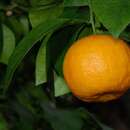en
names in breadcrumbs


Citrus paradisi, grapefruit, is a medium-sized fruit tree in the Rutaceae (citrus family) of recent hybrid origin. It is thought to have originated in the Caribbean as a cross between a pomelo (C. maxima) and a sweet orange (C. sinensis); it was first described in Barbados in the 1750s and popularized in the Caribbean and the U.S. Diverse cultivars of this fruit tree are now cultivated in many tropical, semi-tropical, and warm temperate regions world-wide for the sweet-sour fruit that is often served as a breakfast food.
The grapefruit tree typically grows 4.5 to 6 m (15 to 20 ft) tall, although old trees may grow to heights of 13 m or more, with spiny twigs. The leathery, evergreen leaves are typically ovate, 7.5 to 17.5 cm (3 to 7 in) long, and 4.5 to 7.5 cm wide.The aromatic white flowers usually grow in clusters of 2 to 20 and produce large globose to pear-shaped fruits that ripen to light yellow or yellow orange and are 10 to 15 cm in diameter. Fruits have thick skins pitted with oil glands. Diverse cultivars have been developed, with fruit flesh, which is typically quite juicy, dividing into 11 to 14 segments and varying from yellow to orange to pinkish red, with few to many seeds. Flavor ranges from sweet-tart to sour or bitter. The fruits can be left on the tree for several months to lengthen the harvest season and they keep well in storage.
Grapefruits, which are high in potassium and vitamins A and B but lower in vitamin C than many other citrus fruits, are often served as a fresh fruit—frequently as a breakfast food in the U.S., or sprinkled with sugar and grilled as a dessert. The fruit may be processed into juice for use in beverages, cocktails, fruit salads, sorbets, and desserts, and sometimes used in cooking. The whole fruit can be used to make marmalades.
Grapefruits became famous as a diet food starting in the 1930s, in a diet program again made famous in the 1970s, but claims of their fat-combating properties have not been substantiated. Grapefruits and pomelos do, however, contain a class of compounds, known as furanocoumarin derivatives, that interfere with the action of various prescription medications.
Total 2010 global production of grapefruits (together with pomelos) harvested commercially was 7.0 million metric tons from 269,002 cultivated hectares. China and the U.S. were the leading producers, together producing nearly 60% of the world total. Other major producers include Mexico, South Africa, and Thailand. Grapefruit trees and fruits are susceptible to various pests and pathogens, including the Mediterranean fruit fly (Ceratitis capitata), numerous fungal leaf spots, blights, and root rots (Cercospora, Colletotrichum, Fusarium, Phytophthora, and others) and viruses that can significantly reduce yields.
(Bailey et al. 1976, FAOSTAT 2012, Morton 1987, van Wyk 2005, Zelman 2012, Zeratsky 2012.)